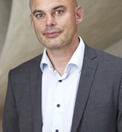Time-resolved imaging of the structural phase transition in VO2. (a) the Ultrafast transmission electron microscope (UTEM) at KTH. (b) High-quality single-crystalline VO2 lamella prepared using FIB at KTH. (c-d) Electron diffraction in VO2 prior and after laser excitation measured as part of the 3DED measurements. The diffraction measurements are repeated over many sample tilts.
Time resolved 3D electron diffraction – Structures at high speed
3-dimensional electron diffraction (3DED) is an established technique that allows for ab-initio three-dimensional crystal structure determination. Advantages of 3DED include that the technique can extract reliable information from very small samples, inhomogeneous transitions, and can be conducted using instrumentation available at university labs, with no need for large scale infrastructures. Over the last few years, automation has made 3DED widely accessible and increasingly user friendly, rendering 3DED competitive with other three-dimensional techniques such as X-ray diffraction or neutron diffraction.
However, 3DED has been restricted to static structures and lacks information of ultrafast dynamics highly desired for applications in materials science, chemistry, and biology. Extending 3DED to the time domain would facilitate the recording of movies of samples as they undergo a change in state, at material relevant spatial (atomic) and temporal (femtosecond) resolutions.
In this joint development effort between KTH and SU, we push 3DED beyond state-of-the-art and demonstrate its extension to the ultrafast domain. With approximately 100 femtosecond time resolution we can follow phase transitions at their intrinsic time scale. Compared to conventional operation of electron microscopes, which exhibits excellent coherence and brightness, an ultrafast TEM is characterized by pulsed operation with low electron flux. We show that despite these limitations, 3DED is feasible in the ultrafast regime and offers immense advantages over conventional 2D diffraction.
Our drosophila material system is vanadium dioxide (VO2), which exhibits a concomitant structural and electronic phase transition near 68°C. This phase transition can be optically driven at below 100 fs and is consequently of great interest for the development of advanced electronic devices, such as high-speed switches and optical detectors. The ultrafast dynamics of this transition are not fully understood, which has hindered its application in devices.
Reconstructed crystal structure using tr-3DED. Surprisingly, we find that the laser-induced structural transition follows a different path compared to the heat-induced phase transition, tentatively influenced by stress in the lamella sample.
Here, by using time-resolved 3-dimensional electron diffraction (tr-3DED), we show that the light-induced phase transition behaves differently from the thermally driven transition. We interpret the results that laser excitation induces acoustic strain waves in the sample, exerting stress on the order of GPa, which leads to a different phase transition trajectory than expected. Given that some of the known crystal structures in VO2 have remarkable similarities, we found that tr-3DED is crucial for unambiguously distinguishing between them.
In summary, we have demonstrated the feasibility of 3DED in the ultrafast regime, which allowed us to unequivocally determine the changes in crystal structure taking place during the transition of VO2. We plan to extend our study by collecting more data sets at later time delays with respect to the laser excitation and hope to observe another structural phase transition once the stress in the lamella has decayed. We believe that ultrafast 3DED will become indispensable for transient structural determination.
This method was developed in collaboration between researchers at the SU and KTH ARTEMI nodes: Arthur Niedermayr (KTH), Gaolong Cao (KTH), Hongyi Xu (SU), Xiaodong Zou (SU), and Jonas Weissenrieder (KTH).







